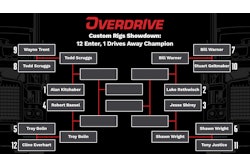Challenging erroneously assigned inspections or crashes, or incorrectly written violations and those tied to citations thrown out in a court of law ... if you're an independent owner-operator with motor carrier authority, it's your responsibility. Leased owner-operators, too, depending on the leasing carrier, might sometimes be a part of the process, too.
Challenges are conducted via the Federal Motor Carrier Safety Administration's DataQs portal. The Owner-Operator Independent Drivers Association offers its members free assistance with navigating this process, as do some electronic logging device vendors and other service providers.
There's plenty you can do yourself, however, to navigate DataQs to challenge unwarranted violations and erroneously assigned crashes or those eligible for preventability review under the FMCSA's Crash Preventability Determination Program.
How to mount an effective challenge: Start at the scene with documentation
Carriers who routinely file DataQs "Requests for Data Review" (RDRs) in FMCSA's system have found that challenges to a violation filed with little evidence that the violation wasn't in fact a violation did little more than make the issuing police agency angry. Depending on what the violation is, and how attentive to the allegation any individual operator was during the inspection, backing up any review request with evidence is key to success in any challenge.

Focus on evidence and facts. Setting up a successful DataQ RDR begins at the scene of the crash or routine roadside or weigh station inspection. The best thing you can do as a carrier is to make sure your DataQ is legitimate. Before ever filing, have the evidence on hand to communicate not just where you feel something is wrong. Make sure you have an underlying set of facts that truly show the problem.
Be savvy with your attitude. Ask the officer to explain any violation at roadside. Too often, when operators are stopped they freeze up, nervous about the interaction. Instead, seek to engage with the officer about his/her thinking when violations are written in the first place. Understanding the officer’s rationale, if it turns out to be in contradiction with whatever regulation he/she believes you’re violating, will give you part of what you need in any eventual challenge.
An officer’s writeup might be clearly incorrect, but in RDR filing you don't want to outright tell the officer they’re wrong. Keep your request for review on the regulatory perspective. Make sure you and/or your drivers know enough to be able to collect the evidence to show where an officer may have misunderstood the situation.
Document the scene, the equipment. If the worst happens and you're in a crash, make sure everyone's OK, then take the time to walk from one side of the scene to the other and snap photographs. After an adverse inspection or crash, take clear pictures of any violation -- after a crash, you want as many of the violations to be deemed post-crash as possible. Equipment problems that resulted from the crash won’t be counted again your CSA scores or driver PSP profiles.
Carriers and drivers who are diligent during roadside stops and post-crash inspections have been shown to have a much higher DataQs review-success rate than others.
Another source of on-the-scene facts can be notes made by the inspecting officer, which many truckers and carriers don’t realize they can request from the department that made the inspection or handled the crash on-scene. Those notes can provide helpful information, such as giving insight to the officer’s rationale behind a violation.
[Related: Setting the record straight: Overdrive's 2021 multipart series investigation DataQs issues]
Preparing to file in DataQs
 This feature is part of Overdrive's coproduction with business services firm ATBS of the Partners in Business manual, a comprehensive playbook for owner-operator careers. Browse the 2025 edition in its new dynamic online library format in eight sections via this link.
This feature is part of Overdrive's coproduction with business services firm ATBS of the Partners in Business manual, a comprehensive playbook for owner-operator careers. Browse the 2025 edition in its new dynamic online library format in eight sections via this link.
Law enforcement officials advise to get your ducks in a row before you submit the RDR. The fairly intuitive system guides you through the process to attach evidence, whether photos or electronic-log data downloads or other supporting documents.
Before starting, make certain you have the “report number” for the record you’re challenging. That should be shown in the CSA Safety Measurement System profile for your business or the Pre-Employment Screening Program report if you’re a driver or leased operator.
A police accident report, for instance, will likely have a different report number, so be sure to use the right one. If you provide the right record number and the inspection and violation are already within the system, DataQs will pre-populate much of the other information that the agency normally requests -- the inspection report number, the issuing state and date of inspection.
Be thorough and professional in filing. In your RDR, use language that shows intent to be thoughtful, clear and concise in describing what the error is believed to be, keeping in mind there are hardworking folks in the various state jurisdictions and in FMCSA itself on the other side of the computer reading, reviewing and, ultimately, making a decision. By submitting all required and otherwise pertinent information up front, reviewers can get through it all more quickly once the review makes its way to the appropriate state jurisdiction, if need be. Often, state jurisdictions and federal reps report, a back-and-forth request further documents can draw out the process of review for weeks.
Don’t forget the final step. Too many filers fail to carefully read and follow the instructions on the DataQs website. Occasionally, federal reps note they learn about requests being automatically closed or otherwise rejected for the simple reason that the requestor failed to click submit.
After filing, expect to wait a few weeks. You'll wait onger if you’re asked to submit other documents. The time to close reviews averaged around two weeks, federal DataQs data showed as of just a few years ago.
If your request is denied, don’t be afraid to appeal. While there’s not an actual “appeal” button in the system, there's a “reply again” function where you can ask directly for an appeal to a secondary level or for a state training officer to look your request and the determination over. Some states, like Minnesota and Arizona, have appeals review boards they convene for intractable disputes, but most don’t. When requesting an appeal above the first level, you can ask about the possibility of review of any officer-shot video or inspection notes if it conceivably would back your argument.
In 2023, FMCSA proposed to take control of third-stage appeals centrally within the agency, requesting comment from trucking stakeholders with a notice. Time will tell whether new procedures for third-stage appeals come into play. As of February 2025, appeals processes remained similar to what's described here.
[Related: FMCSA proposes federal system for third-stage DataQs appeals]
Don’t neglect adjudicated citations
Perhaps the simplest route toward success in a violation challenge is when you’ve received a not-guilty verdict in the court system for something associated with the citation/ticket. In 2014, FMCSA introduced a policy to remove violations from its system or reduce severity weighting if a ticket was thrown out by the court or if the cited driver was convicted of a lesser charge.
While this can prove to be low-hanging fruit, it can take a lot of time. The agency will ask for the inspection report number, the issuing state and date of inspection. For the citation, then, it wants the citation/ticket number and associated violation codes on the inspection report. Copies of court documentation, too, are required, and copies of both the ticket and inspection report are recommended.
As illustrated in the graphic from Part 3 of Overdrive's 2021 feature series about the DataQs system, violation challenges associated with citation adjudication are more likely than any other category to be successful, so don’t neglect to file a DataQ after a favorable court resolution of a ticket.
In some cases, this isn’t an option. Inspection-reported-noted violations that accompany written warnings, such as for speeding, can’t be taken to court -- and therefore adjudicated -- because no citation was issued.
Read next: Preventable or not? When to use DataQs to request crash reviews for preventability










